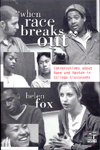 I want to be clear: I say this with absolutely no shame. There are few sorrows in life that cannot be soothed by a good musical. And there are few Great, Universal Wisdoms that have not already been belted from center stage as a mighty ballad, or twittered by the chorus in the form of a pithy, merry little rhyme. If that weren't enough, often there is dancing, too.
I want to be clear: I say this with absolutely no shame. There are few sorrows in life that cannot be soothed by a good musical. And there are few Great, Universal Wisdoms that have not already been belted from center stage as a mighty ballad, or twittered by the chorus in the form of a pithy, merry little rhyme. If that weren't enough, often there is dancing, too. When done properly, the audience is rapt, destined to be humming the melodies and reciting the lyrics for days afterwards (whether they would like to or not). Teachers can only dream of such assimilation! Imagine students being punished at home for singing about the Oka Crisis at the dinner table. Or hearing on a city bus: “Oh, was I doing it again? I’m sorry; I just can’t get the damn parabola song out of my head! Would that I could somehow forget that y equals the square of x!”
(A notice to Mr. Instructor: in no way do I mean this to be a suggestion for, or critique of, your pedagogy. Your non-musical, non-rhyming, non-dancing lecture style is gripping, in its own way.)
But I’ll be serious now - I want to explain the title of my blog for those who are not familiar with the reference. ‘The King and I’ is the (liberally dramatized) story of Anna Leonowens, an English widow who traveled to Thailand to teach English to the children of King Mongkut of Siam in the early 1860s. The show entertains with a comical and often touching clash of cultures; some of the misunderstandings are delicious. Others are devastating.
 ‘Etcetera’ is the first word that Anna teaches the King, who is of the kingly opinion that he is not in need of any instruction. Especially not from a westerner. Certainly not from a woman. And yet what fun he has with his new knowledge! Throughout the musical the King uses the word at every opportunity, haughtily repeating it with the kind of grandiose gesticulation that merits my use of capital letters – “Etcetera… Etcetera… Etcetera!”
‘Etcetera’ is the first word that Anna teaches the King, who is of the kingly opinion that he is not in need of any instruction. Especially not from a westerner. Certainly not from a woman. And yet what fun he has with his new knowledge! Throughout the musical the King uses the word at every opportunity, haughtily repeating it with the kind of grandiose gesticulation that merits my use of capital letters – “Etcetera… Etcetera… Etcetera!” Such joyous student triumph is the teacher’s Grail. It is the students’ too, though some of them may not realize it until the prize accidentally lands in their insolent little laps. I selected this quotation to remind us all of the elation that comes with learning something new. I selected it because I believe that the joy of learning is a powerful tool for bridging the gaps between us.
But I do not mean to imply that the differences, and even misunderstandings, are exclusively obstacles to be overcome. Perhaps, too, it is the differences between us that galvanize the leaning process. Anna might well argue that she learned as much from her students than they did from her. Her students might say they learned more from her than they ever could have from a local teacher. (At least, this is the happy gist of the musical.)
In this sense, the diverse nature of Canada's schools should be seen as an issue to be managed but not over-managed, so as not to squander the opportunity for leaning. Striking the ideal balance is, I'm sure, not easy. And so I will conclude this post with the hope that this course sets us in the direction of success, and that by the end, if we are not humming, skipping, or singing, we are at least in possession of knowledge and perspective which will serve us well in practice.
I welcome comments & discussion. Extra imaginary super bonus points if you can make them rhyme.












No comments:
Post a Comment